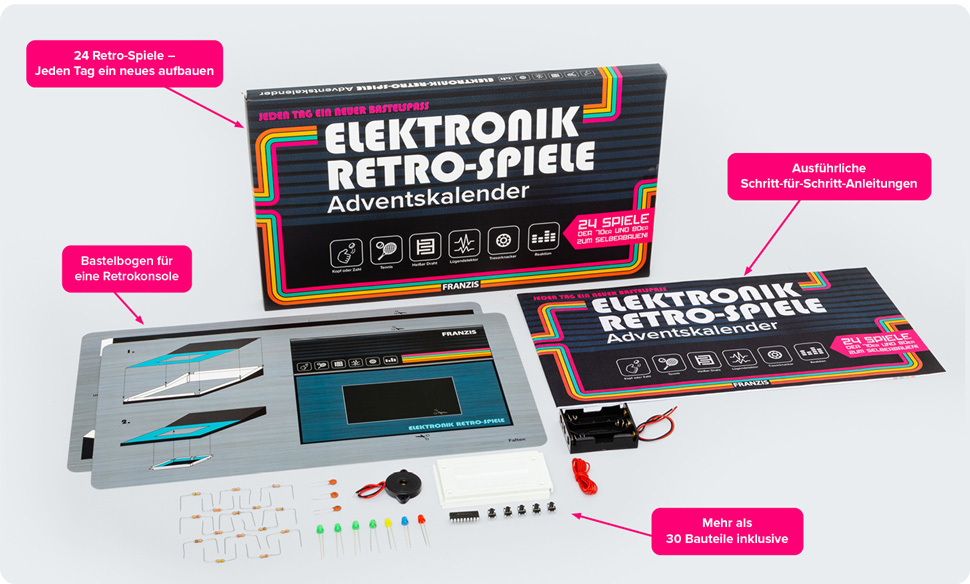Advent Calendar Review: Electronic Retro Games
Inhalt/Content
Ah yes, Advent is just around the corner again and why not do an Advent calendar review? What, before the actual advent? Yes, because I’ve had this calendar lying around here for over 2 years and only now got around to “playing” it to the end. But first the history…
As you know, I’m a gamer, I’ve played hundreds of games (mostly RPGs) and occasionally come into contact with retro games from the NES and SNES era. I’ve also sometimes been tempted to buy one of the mini consoles that Nintendo, Sega and other game console manufacturers have been offering in recent years. A few years ago I came across this advent calendar, which looks very similar to an Atari 2600 (one of the first home game consoles). So why not buy this comparatively cheap advent calendar for mini consoles, where you can even assemble the console yourself? (like a model kit)
To put it briefly and in advance: The “device” that you assemble here has absolutely nothing to do with the game consoles of the time and the presentation is probably intended to deceive and make false advertising. Nevertheless, the advent calendar is not a total letdown, but has actually become quite interesting…
Construction and games of the advent calendar
Franzis’ advent calendar was published in 2019 and I think it’s been lying around in our apartment ever since. Since, of course, no year is indicated on it, the advent calendar is sold new every year or placed in the shop counter. The price fluctuates somewhere between 20 and 30 euros, although we bought it for just over 10 euros because it was sold at a 50% discount after the first days of Advent. As mentioned in the introductory text above, the reason I was so interested in the calendar was that I thought, “What? A retro mini-console for only like $10 that you can assemble yourself? Sure, I’ll have it!” – well, I was way off the mark here.

The advent calendar has, how could it be otherwise, 24 little doors. Each of them corresponds to a new game with the respective components in it, which can be assembled. Since I got the calendar later (as I said, I only bought it a few days during Advent), I immediately opened several doors, which was more of a mistake, because I then had to distinguish between resistors that often look very similar. Here I come to the first small point of criticism: Yellow lines on resistors are practically not recognizable because the resistors themselves are almost the same shade of yellow.
The first games, logically with few components, were therefore also very simple. Often these have been as simple as checking a cable, a coin toss, or a “slot machine” with randomly lit LED lights. But since the “randomness” here wasn’t always so good (e.g. one LED flashed slower than the other), the games were also just so-so.
It got interesting at door 6 with the “hot wire” – but this wasn’t implemented so cleanly either. There were two reasons for this: Firstly, it was the length of the available wire. This is covered with red rubber and maybe only 30cm long. But since you already had to use this to cut off small connection cables, there wasn’t much left for it. Barely enough to take out a long wire that can serve as a labyrinth for the hot wire. Also, since the wire was completely sheathed, detaching the red sheath would have been a huge job. Luckily I still had wire from my model kits and cosplay build so I was able to use that instead.
The other reason is the structure itself, because not only the wire itself has to be connected to the breadboard, but also the “ring” that is guided by the person (otherwise there would be no error tone). So you can’t really move and rotate the ring around curves when it’s still connected to the board with a wire.
Continuing with “long wires” there was also a lie detector in game 11. This one changes tone when you lie more (i.e. sweat), but as you can imagine, that didn’t work out too well either.

Later I started to record the games with the camera because Nathalie was often unable to attend the “handicraft evening” because of Aikido, but I wanted to show her the games before I had to rearrange the board with the next little door. So it went on with door 12, the “hearing test”. Hardly to be described as an actual game, an ever-higher tone is played here, which at some point you supposedly can no longer hear. Some of these sounds are said to be annoying for cats and dogs too… and at least Yuri stood up during the test 😅 But I somehow dare to doubt whether the small speaker can really produce such sounds. I think it just stopped playing the higher notes at some point.
Shortly afterwards there was a game of “Tennis”. You might think of something like Pong here (which I would have expected from a retro console with a screen), but it was just a bunch of LEDs flashing from left to right and back again. And when it flashes on the far left, you have to press a switch to continue… not exactly exciting, as the video also shows.
Up until 24, many games were somehow thematically repetitive when it came to either reaction or random events. Only the last game to door 24 was really successful again. It was the well-known “Simon Says”, where a pattern is given which is always extended by one element and you have to press it. I was amazed before how different “melodies” can be created using only power lines and resistance, but a game that randomly sets patterns with little lights and expands them more and more with fanfare of victory and defeat, that blew my mind. In the end you could also put the breadboard with all the parts inside the paper box taped together so it really looks like a retro console.
From the videos you can already see that the parts did not always fit neatly on the breadboard. So sometimes cables slipped out again or, which was often the case: the switches, especially when pressed, were very wobbly and were not always recognized. It is also interesting to mention that the description and the inventory didn’t work properly for once. So there should be a yellow LED in door 5, but there was a blue one in it. That’s why my structure always looked slightly wrong based on the sketch. The blue LED should only be in door 23, but (who would have thought it) was the yellow one in here. So they were swapped. It is questionable whether this was an isolated case or whether this mistake was made in several product lines. At least on the product photos in the shop pages you can see that there are slightly different versions of this calendar, but apparently only a few colors were exchanged for them.
Conclusion
Personally, I have always found it difficult to deal with electrical engineering. In lectures I was rather passive and I always wanted to do a lot with Arduino and Co, but never really came into contact with them. The calendar is a nice start for young and old to get into the topic. Sure it’s a bit of an illusion to choose the design of an old games console here and the material is also a bit meager here and there (like not enough cables and wobbly switches), but overall it was fun to put the games together and it was impressive what can be achieved with few resources.
My review: ★★★★☆
- 24 games with some really good ideas
- Successful introduction to electrical engineering with explanatory information boxes
- Amazing results with little technique
- Deceptive advertising with Atari retro console form
- Partly scarce or cheap material
- Some of the explanatory texts formulated somewhat incomprehensibly about the structure
